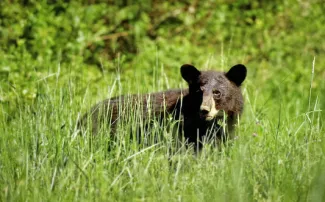
Black bears are established in southeastern and east-central Oklahoma, but sightings are possible anywhere in the eastern half of the state and the western tip of the Panhandle. (USFWS)
Encountering a black bear in Oklahoma is a real possibility, a fact that still surprises many residents and visitors who never realized the animals are commonly seen in some parts of the state.
Anyone in Oklahoma east of Interstate 35 could encounter black bears as they emerge from dens after winter and become active during spring and summer, said Joe Hemphill, Southeast Region Wildlife Supervisor with the Oklahoma Department of Wildlife Conservation.
In the past few years, black bear sightings have been progressing farther west from the bears’ primary range in southeastern and east-central Oklahoma. In recent years, black bears have been seen in Ada and Wewoka, as far north as Broken Arrow, and as far west as Wayne.
Black bears are most active at night, Hemphill said. This poses a potential risk to motorists after sunset in areas where bear populations exist. About 10 p.m. April 18, a bear-vehicle collision occurred near Stilwell in Adair County.
During summer months, the female bears, called sows, will likely have cubs in tow as they forage for food. The black bear's natural diet includes nuts, berries, grasses, insects, eggs, honey, small mammals and carrion. But bears are opportunists and can be attracted by easy food sources provided by people, such as unsecured garbage or pet food left outdoors.
To minimize the chances of attracting bears, always make sure that garbage is kept in sealed containers and pet food is not left outside. Never purposely feed wild bears, experts say.
In areas where bears are common, you can help decrease the chances of a nuisance bear encounter by:
- Rinsing outdoor trash containers with ammonia to eliminate odors.
- Storing cooking grills inside, or cleaning them of food residue after each use.
- Considering taking down backyard bird feeders for the summer and early fall, as the birds have plenty of wild food sources during those months.
Upon sighting a bear, experts say the best thing to do is to remain calm and leave the area to allow the bear to move along on its own. If a bear is encountered at close range, experts offer these safety tips:
- Do not turn and run, as that might elicit a chase response in the bear.
- Stand and face the bear, holding out your arms or jacket to appear as large as possible.
- Try to retreat slowly, but don’t block the bear’s escape route.
- If you cannot leave the area, make loud noises that could make the bear flee, such as yelling or banging on pots or pans.
Finally, anyone whose outdoor activities increase the chances of a bear encounter can carry bear repellent spray with them, Hemphill said, which can be used if a bear charges. In the unlikely event a bear charges to attack, you should aggressively fight back against the bear, according to the Southeastern Association of Fish and Wildlife Agencies. Do not attempt to “play dead” during a black bear attack, the agency says.
To report a nuisance black bear in areas north of Interstate 40, call Senior Wildlife Biologist Mike Plunkett at (918) 625-3910 or Senior Wildlife Biologist J.D. Ridge at (918) 617-1113. To report a nuisance bear in areas south of I-40, call Senior Wildlife Biologist Jeff Ford at (918) 527-9918 or Wildlife Technician Matt Hensley, (918) 260-3920. Nuisance bears may also be reported to any local Game Warden. A Game Warden directory is available at wildlifedepartment.com.